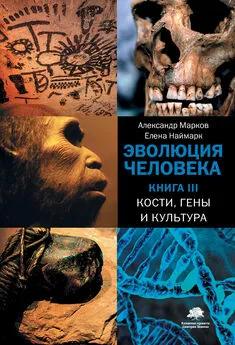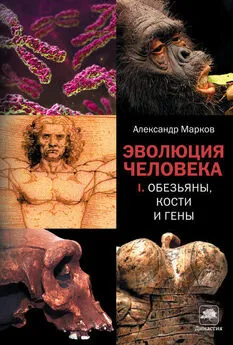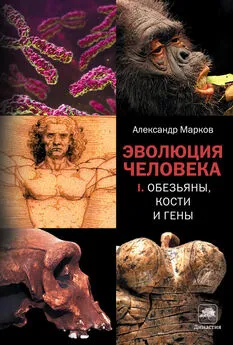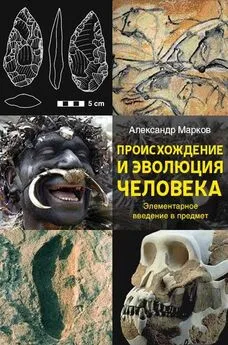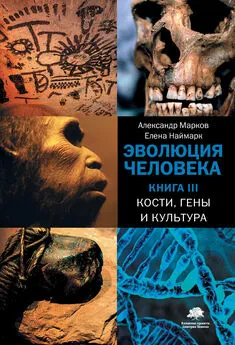Александр Марков - Эволюция человека. Книга 3. Кости, гены и культура
- Название:Эволюция человека. Книга 3. Кости, гены и культура
- Автор:
- Жанр:
- Издательство:АСТ : CORPUS
- Год:2022
- Город:Москва
- ISBN:978-5-17-137580-5
- Рейтинг:
- Избранное:Добавить в избранное
-
Отзывы:
-
Ваша оценка:
Александр Марков - Эволюция человека. Книга 3. Кости, гены и культура краткое содержание
Эволюция человека. Книга 3. Кости, гены и культура - читать онлайн бесплатно ознакомительный отрывок
Интервал:
Закладка:
Plummer T. 2004. Flaked stones and old bones: biological and cultural evolution at the dawn of technology // American Journal of Physical Anthropology. V. 125. P. 118–164.
Potter B. A. et al. 2014. New insights into Eastern Beringian mortuary behavior: a terminal Pleistocene double infant burial at Upward Sun River // PNAS. V. 111. P. 17060–17065.
Potts R. et al. 2018. Environmental dynamics during the onset of the Middle Stone Age in eastern Africa // Science. V. 360. P. 86–90.
Proffitt T. et al. 2016. Wild monkeys flake stone tools // Nature. V. 539. P. 85–88.
PrÜfer K. et al. 2014. The complete genome sequence of a Neanderthal from the Altai Mountains // Nature. V. 505. P. 43–49.
Raghanti M. A. et al. 2018. A neurochemical hypothesis for the origin of hominids // PNAS. V. 115. P. E1108–E1116.
Raghavan M. et al. 2014. Upper Palaeolithic Siberian genome reveals dual ancestry of Native Americans // Nature. V. 505. P. 87–91.
Raihani N. J., Ridley A. R. 2008. Experimental evidence for teaching in wild pied babblers // Animal Behaviour. V. 75. P. 3–11.
Rasmussen M. et al. 2011. An Aboriginal Australian genome reveals separate human dispersals into Asia // Science. V. 334. P. 94–98.
Rasmussen M. et al. 2014. The genome of a Late Pleistocene human from a Clovis burial site in western Montana // Nature. V. 506. P. 225–229.
Reardon P. K. et al. 2018. Normative brain size variation and brain shape diversity in humans // Science. V. 360. P. 1222–1227.
Reich D. et al. 2012. Reconstructing Native American population history // Nature. V. 488. P. 370–374.
Rendell L. et al. 2010. Why copy others? Insights from the social learning strategies tournament // Science. V. 328. P. 208–213.
Richter D. et al. 2017. The age of the hominin fossils from Jebel Irhoud, Morocco, and the origins of the Middle Stone Age // Nature. V. 546. P. 293–296.
Roebroeks W. et al. 2011. Use of red ochre by early Neandertals // PNAS. V. 109. P. 1889–1894.
Roffman I. et al. 2012. Stone tool production and utilization by bonobo-chimpanzees ( Pan paniscus ) // PNAS. V. 109. P. 14500–14503.
Rogers A. R. 2019. Legofit: estimating population history from genetic data // BMC Bioinformatics. V. 20. 526.
Rogers A. R. et al. 2020. Neanderthal-Denisovan ancestors interbred with a distantly related hominin // Science Advances. V. 6. eaay5483.
Rogers M. J. et al. 1994. Changing patterns of land use by Plio-Pleistocene hominids in the Lake Turkana Basin // Journal of Human Evolution. V. 27. P. 139–158.
Rolandsen C. M. et al. 2016. On fitness and partial migration in a large herbivore – migratory moose have higher reproductive performance than residents // Oikos. V. 126. P. 547–555.
Rose L., Marshall F. 1996. Meat eating, hominid sociality, and home bases revisited // Current Anthropology. V. 37. P. 307–338.
Sahnouni M. et al. 2018. 1.9 -million– and 2.4 -million-year-old artifacts and stone tool – cutmarked bones from Ain Boucherit, Algeria // Science. V. 362. P. 1297–1301.
Sallet J. et al. 2011. Social network size affects neural circuits in macaques // Science. V. 334. P. 697–700.
Samuni L. et al. 2017. Oxytocin reactivity during intergroup conflict in wild chimpanzees // PNAS. V. 114. P. 268–273.
Sandom C. et al. 2014. Global late Quaternary megafauna extinctions linked to humans, not climate change // Proceedings of the Royal Society B. V. 281. 20133254.
Sankararaman S. et al. 2014. The genomic landscape of Neanderthal ancestry in present-day humans // Nature. V. 507. P. 354–357.
Sanz C. et al. 2009. Design complexity in termite-fishing tools of chimpanzees ( Pan troglodytes ) // Biology Letters. V. 5. P. 293–296.
Schiller F. 1997. The cerebral ventricles. From soul to sink // Archives of Neurology. V. 54. P. 1158–1162.
Schoenemann P. T. 2006. Evolution of the size and functional areas of the human brain // Annual Review of Anthropology. V. 35. P. 379–406.
Schuenemann V. J. et al. 2017. Ancient Egyptian mummy genomes suggest an increase of Sub-Saharan African ancestry in post-Roman periods // Nature Communications. V. 8. 15694.
Segurel L. et al. 2020. Why and when was lactase persistence selected for? Insights from Central Asian herders and ancient DNA // PLoS Biology. V. 18. e3000742.
Shulman R. G. et al. 2004. Energetic basis of brain activity: implications for neuroimaging // Trends in Neurosciences. V. 27. P. 489–495.
Sikora M. et al. 2014. Population genomic analysis of ancient and modern genomes yields new insights into the genetic ancestry of the Tyrolean Iceman and the genetic structure of Europe // PLoS Genetics. V. 10. e1004353.
Sikora M. et al. 2017. Ancient genomes show social and reproductive behavior of early Upper Paleolithic foragers // Science. V. 358. P. 659–662.
Sikora M. et al. 2019. The population history of northeastern Siberia since the Pleistocene // Nature. V. 570. P. 182–188.
Simonti C. N. et al. 2016. The phenotypic legacy of admixture between modern humans and Neanderthals // Science. V. 351. P. 737–741.
Skinner M. M. et al. 2015. Human-like hand use in Australopithecus africanus // Science. V. 347. P. 395–399.
Skoglund P. et al. 2015. Genetic evidence for two founding populations of the Americas // Nature. V. 525. P. 104–108.
Slon V. et al. 2017. A fourth Denisovan individual // Science Advances. V. 3. e1700186.
Slon V. et al. 2018. The genome of the offspring of a Neanderthal mother and a Denisovan father // Nature. V. 561. P. 113–116.
Smith F. A. et al. 2018. Body size downgrading of mammals over the late Quaternary // Science. V. 360. P. 310–313.
Smith T. M. et al. 2018. Wintertime stress, nursing, and lead exposure in Neanderthal children // Science Advances. V. 4. eaau9483.
Sobolewski М. E. et al. 2012. Territoriality, tolerance and testosterone in wild chimpanzees // Animal Behaviour. V. 84. P. 1469–1474.
Sousa A. M. M. et al. 2017a. Evolution of the human nervous system function, structure, and development // Cell. V. 170. P. 226–247.
Sousa A. M. M. et al. 2017b. Molecular and cellular reorganization of neural circuits in the human lineage // Science. V. 358. P. 1027–1032.
Spoor F. et al. 2015. Reconstructed Homo habilis type OH 7 suggests deep-rooted species diversity in early Homo // Nature. 2015. V. 519. P. 83–86.
Stanyon R., Bigoni F. 2014. Sexual selection and the evolution of behavior, morphology, neuroanatomy and genes in humans and other primates // Neuroscience and Biobehavioral Reviews. V. 46. P. 579–590.
Street S. E. et al. 2017. Coevolution of cultural intelligence, extended life history, sociality, and brain size in primates // PNAS. V. 114. P. 7908–7914.
Stringer C. 2012. Lone survivors. How we came to be the only humans on Earth . New York: Times Books. [Стрингер К. 2021. Остались одни . М.: Corpus.]
Sutikna T. et al. 2016. Revised stratigraphy and chronology for Homo floresiensis at Liang Bua in Indonesia // Nature. V. 532. P. 366–369.
Tackney J. C. et al. 2015. Two contemporaneous mitogenomes from terminal Pleistocene burials in eastern Beringia // PNAS. V. 112. P. 13833–13838.
Tanaka M. et al. 2018. A mesocortical dopamine circuit enables the cultural transmission of vocal behaviour // Nature. V. 563. P. 117–120.
Thornton A., McAuliffe K. 2006. Teaching in wild meerkats // Science. V. 313. P. 227–229.
Tocheri M. W. 2019. Previously unknown human species found in Asia raises questions about early hominin dispersals from Africa // Nature. V. 568. P. 176–178.
Turk M. et al. 2020. The Neanderthal musical instrument from Divje Babe I cave (Slovenia): a critical review of the discussion // Applied Sciences. V. 10. P. 1226.
Vallentin et al. 2016. Inhibition protects acquired song segments during vocal learning in zebra finches // Science. V. 351. P. 267–271. (Видеофильм к статье: http://science.sciencemag.org/highwire/filestream/ 672448 /field_highwire_adjunct_files/ 1 /aad 3023 s 1 .avi. )
Van den Bergh G. D. et al. 2016a. Homo floresiensis -like fossils from the early Middle Pleistocene of Flores // Nature. V. 534. P. 245–248.
Van den Bergh G. D. et al. 2016b. Earliest hominin occupation of Sulawesi, Indonesia // Nature. V. 529. P. 208–211.
Van Leeuwen E. J. C. et al. 2014. A group-specific arbitrary tradition in chimpanzees ( Pan troglodytes ) // Animal Cognition. V. 17. P. 1421–1425.
Van Neer W. et al. 2014. More evidence for cat taming at the Predynastic elite cemetery of Hierakonpolis (Upper Egypt) // Journal of Archaeological Science. V. 45. P. 103–111.
Vernot B., Akey J. M. 2014. Resurrecting surviving Neandertal lineages from modern human genomes // Science. V. 343. P. 1017–1021.
Vernot B. et al. 2016. Excavating Neandertal and Denisovan DNA from the genomes of Melanesian individuals // Science. V. 352. P. 235–239.
Vigne J.-D. et al. 2004. Early taming of the cat in Cyprus // Science. V. 304. P. 259.
Villmoare B. et al. 2015. Early Homo at 2.8 Ma from Ledi-Geraru, Afar, Ethiopia // Science. V. 347. P. 1352–1355.
Wall et al. 2013. Higher levels of neanderthal ancestry in East Asians than in Europeans // Genetics. V. 194. P. 199–209.
Welker F. et al. 2016. Palaeoproteomic evidence identifies archaic hominins associated with the Châtelperronian at the Grotte du Renne // PNAS. V. 113. P. 11162–11167.
Werdelin L., Lewis M. E. 2013. Temporal change in functional richness and evenness in the Eastern African Plio-Pleistocene carnivoran guild // PLoS ONE. V. 8. e57944.
Whiten A. et al. 1999. Cultures in chimpanzees // Nature. V. 399. P. 682–685.
Whiten A., van Schaik C. P. 2007. The evolution of animal “cultures” and social intelligence // Philosophical Transactions of the Royal Society B. V. 362. P. 603–620.
Whiten A. et al. 2017. The extension of biology through culture // PNAS. V. 114. P. 7775–7781.
Whiten A., Byrne R. W. 1988. Tactical deception in primates // Behavioral and Brain Sciences. V. 11. P. 233–244.
Wilkinson A. et al. 2010. Social learning in a non-social reptile ( Geochelone carbonaria ) // Biology Letters. V. 6. P. 614–616.
Wilson A. C. 1985. The molecular basis of evolution // Scientific American. V. 253. P. 164–173.
Wilson M. L. et al. 2014. Lethal aggression in Pan is better explained by adaptive strategies than human impacts // Nature. V. 513. P. 414–417.
Yang A. M. et al. 2017. 40,000 -year-old individual from Asia provides insight into early population structure in Eurasia // Current Biology. V. 27. P. 1–7.
Yeo B. T. T. et al. 2011. The organization of the human cerebral cortex estimated by intrinsic functional connectivity // Journal of Neurophysiology. V. 106. P. 1125–1165.
Zeberg H., PÄÄbo S. 2020. The major genetic risk factor for severe COVID- 19 is inherited from Neanderthals // Nature. V. 587. P. 610–612.
Читать дальшеИнтервал:
Закладка:
